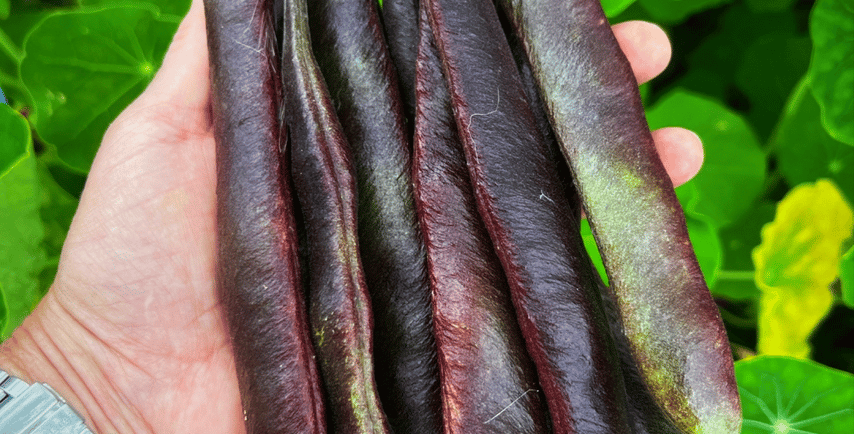FREE UK P&P ON ORDERS £20+
DEFRA LICENSED - 100% HEIRLOOM, OPEN-POLLINATED, SMALL BATCH, HIGH QUALITY SEEDS
Sowing & Growing Beans
The legume family of plants are mostly grown for their pods.
4/1/20244 min read



Runner Beans
Runner beans are a popular choice for both home gardeners and allotment holders due to their delicious taste and high yield. Last year I grew a fabulous Heirloom Variety Black Knight (shown in the image above). Here are some tips for sowing and growing runner beans:
Sowing Direct or In Modules
Runner beans are best sown directly into the ground after the last frost has passed say most gardeners, however predominantly I sow them in modules in the greenhouse in April. If you're sowing direct choose a sunny spot in your garden with well-drained soil. If you're a digger, dig a trench that is about 5cm deep and 30cm wide. Place the runner bean seeds in the trench, spacing them about 15cm apart. Cover the seeds with soil and water gently. Keep the soil moist but not waterlogged.
If you're NO DIG like me, and sowing direct make a small planting hole 5cm deep for each seed spaced approximately 15cm apart. Cover the seeds and water gently.
If you're sowing them in the greenhouse too, use larger (5cm deep) module trays, cardboard toilet roll inners work amazingly well and the whole thing can be planted. Lay one seed flat on the PFC and push it in gently, cover with compost and water.
Growing
Once the runner bean plants start to grow, provide them with support such as trellises or canes, as they're climbers they'll need something to climb up and support them. Ensure that your structure is robust enough to handle the weight of these vigorous climbers and their prolific crop!
Water the plants regularly they're a thirsty crop, especially during dry spells. Mulch around the base of the plants to help retain moisture and suppress weeds.
Runner beans are heavy feeders, so it's important to use a balanced fertilizer and follow the instructions on the packaging. I personally use comfrey tea that I make either at home or on the plot.
Harvest the runner beans when they are young and tender. Pick them regularly to encourage more beans to grow. If you're wanting the beans to dry for storage leave the pods on the plant for the beans to swell. Dry runner beans will keep in a jar for over 12 months, however ensure that they are fully dry.
French Climbing Beans
French climbing beans, also known as pole beans, are another great option for home gardeners and allotmenteers, here's how to sow and grow them:
Sowing
Sow French climbing bean seeds directly into the ground after the last frost. Choose a sunny spot with well-drained soil. Dig a trench that is about 5cm deep and 30cm wide. For the NO DIG method refer to the above sowing information on runner beans.
Place the bean seeds in the trench, spacing them about 15cm apart. Cover the seeds with soil and water gently. Keep the soil moist but not waterlogged.
If you're sowing them in the greenhouse too, use larger (5cm deep) module trays, cardboard toilet roll inners work amazingly well and the whole thing can be planted. Lay one seed flat on the PFC and push it in gently, cover with compost and water.
Growing
As the French climbing bean plants grow, provide them with support such as trellises or canes, as they're climbers they'll need something to climb up and support them. Ensure that your structure is robust enough to handle the weight of these vigorous climbers and their prolific crop!
Water the plants regularly they're a thirsty crop, especially during dry spells. Mulch around the base of the plants to help retain moisture and suppress weeds.
French climbing beans are also heavy feeders, so it's important to use a balanced fertilizer and follow the instructions on the packaging. I personally use comfrey tea that I make either at home or on the plot
Harvest the beans when they are young and tender. Regular harvesting will encourage more beans to grow.
Dwarf Beans
Dwarf beans, also known as bush beans, are a compact variety that is perfect for smaller gardens or containers. Here's how to sow and grow them:
Sowing
Sow dwarf bean seeds directly into the ground after the last frost. Choose a sunny spot with well-drained soil. Dig a trench that is about 5cm deep and 35cm wide. Cover the seeds with soil and water gently. Keep the soil moist but not waterlogged. For the NO DIG method refer to the above sowing information on runner beans, however sow them a little further apart at 35cm each way to make it easier to find and pick the pods.
If you're sowing them in the greenhouse too, use 3cm deep module trays. Lay one seed flat on the PFC and push it in gently, cover with compost and water.
Growing
Dwarf beans don't require support like runner beans or French climbing beans. They have a bushy growth habit and will support themselves.
Water the plants regularly, especially during dry spells. Mulch around the base of the plants to help retain moisture and suppress weeds.
Like other bean varieties, dwarf beans benefit from regular feeds. Use a balanced fertilizer and follow the instructions on the packaging, or comfrey tea like me!
Harvest the beans when they are young and tender. Regular harvesting will encourage more beans to grow.
With these tips, you'll be able to successfully sow and grow runner beans, French climbing beans, and dwarf beans in your own garden. Enjoy the delicious taste of homegrown beans!
